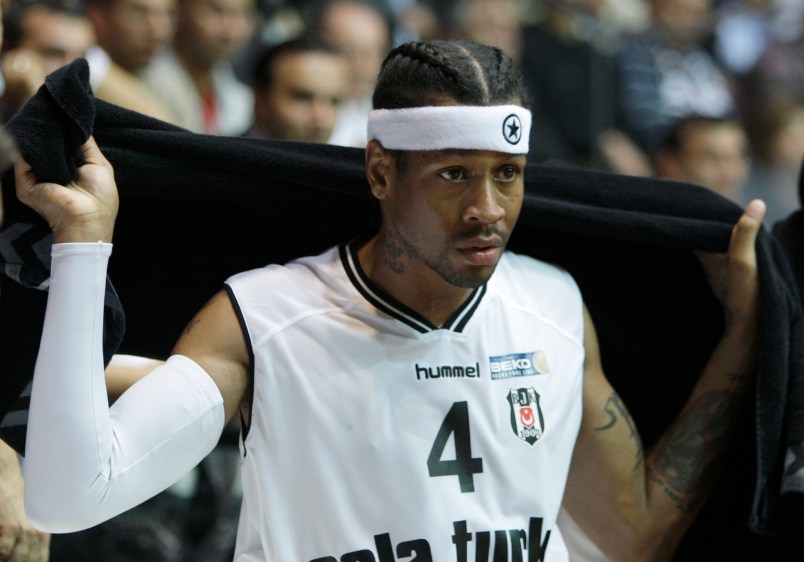I started watching basketball as a child. As a 12-year-old girl growing up in suburban Arizona, I remember all too well the heated 1993 championship series the Phoenix Suns played against the Chicago Bulls, and the heartbreak I felt as Jon Paxson’s 3-point shot led the Bulls to their first three-peat of the ’90s. As a college student at the University of Arizona, I fell in love with the Arizona Wildcats and March Madness along with my classmates. The start of each new season still makes me giddy: now living in the Bay Area, watching the rise of the Golden State Warriors is probably my favorite pastime. It’s hard not to become swept up in the pace of the game — particularly the NBA, with all of the cult of personality and showboating and decadence it fosters.
And over these many years of enjoying games with friends and family, I recall one observation being regularly thrown around: the NBA is an “escape” for young black children from poor backgrounds.
Sometimes, this is true. Allen Iverson, who played in the NBA for 15 years (Detroit Pistons, Denver Nuggets, Philadelphia 76ers) has a story of triumph over economic odds. Bleacher Report wrote in 2008 that, when he was a child, “Iverson’s house would sometimes be engulfed in sewage after the sewage line blew under his house. His mother couldn’t always work and the family would go without water, heating and lighting for days. When asked what he wanted to do after he left school, Iverson often referred to ‘the Plan.’ The plan was to make it through high school, go to college and earn a place in the NBA. He stuck to the plan and become one of the best basketball players ever.”
But research published in the New York Times recently reveals that Iverson’s story is not common at all. In fact, poor children have less of a shot of making it into the NBA — and many professional sports — than their wealthier competitors.
New York Times writer Seth Stephens-Davidowitz calculated the probability of making it into the NBA by race. Of the counties he studied, children raised in the richest 20 percent of black households have the best chances of making it into the NBA. Black males who are raised by single mothers have lower chances of making it into the league. (Single mothers are also saddling the toughest economic burdens.) All of this led Stephens-Davidowitz to conclude that “growing up in a wealthier neighborhood is a major, positive predictor of reaching the NBA.”
Just like that, empirical evidence can upend popular belief. And we should be worried about Stephens-Davidowitz’s conclusion. Particularly given recent research about the effects of poverty on children, it makes perfect sense that a league that requires near superhuman physical and mental endurance as a prerequisite for all of the pay and glory isn’t exactly easy to get into unless you grew up in a household with some basic economic security.
Emily Badger of The Atlantic reported about the “long-term arc of poverty,” that children who grow up poor have impaired brain function as adults. “Experiencing poverty is like knocking 13 points off your IQ as you try to navigate everything else. That’s like living, perpetually, on a missed night of sleep,” Badger wrote.
Badger has previously noted that “The limited bandwidth created by poverty directly impacts the cognitive control and fluid intelligence that we need for all kinds of everyday tasks.”
Beyond everyday tasks, elite athletes have been found to possess a special type of intelligence, particularly the ability to react to complex stimuli. Intelligence requires the kind of focus that, as Badger’s articles discuss, poverty may prevent children from cultivating.
There are links between socioeconomic status and the frequency of sports participation, too. A study published by the National Institutes of Health in 2008 found that “Unfavorable perceived neighborhood factors (e.g., feeling unsafe, small social network), household factors (material and social deprivation), and individual physical activity cognitions (e.g., negative outcome expectancies, low self-efficacy) were significantly associated with doing no sports and were reported more frequently among lower socioeconomic groups.”
Poverty in the United States is persistent, disproportionately impacts children of color and is growing worse. Census data revealed this year that 47 million Americans are living in poverty. Twenty-one percent of U.S. children live in poverty. And poverty rates are growing for African-American families.
Rather than addressing poverty — and cultivating an even stronger pool of athletes, doctors, lawyers, teachers, leaders — politics has focused on eliminating public benefits. Opportunities for work are growing fastest in low-wage sectors. It takes a village to raise an athlete — and our villages aren’t doing so well.
Bapat is an attorney and writer covering economic and gender justice. Her work has appeared in RH Reality Check, Salon, TruthOut, Jacobin and other publications.






